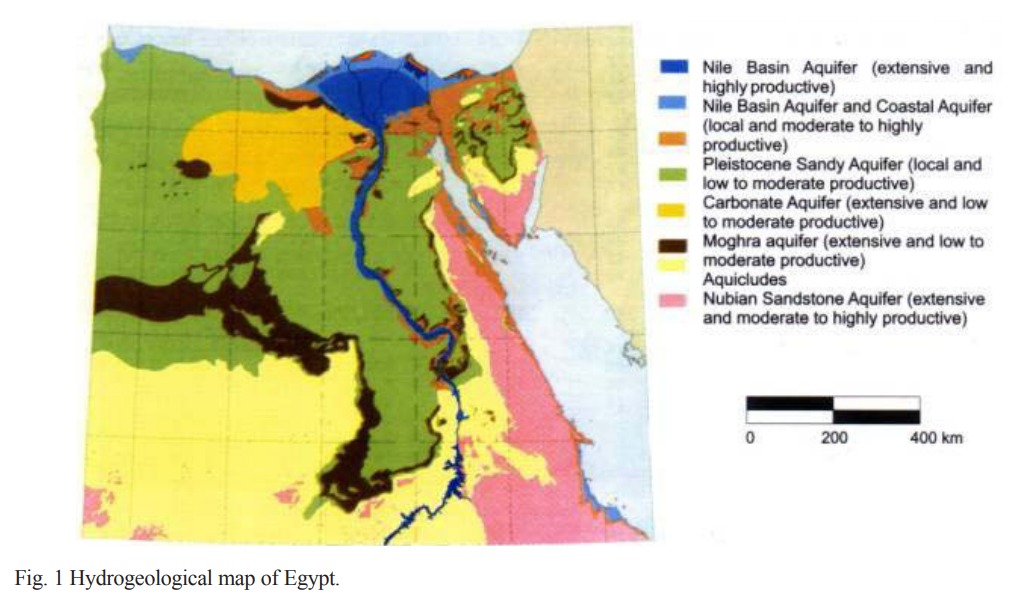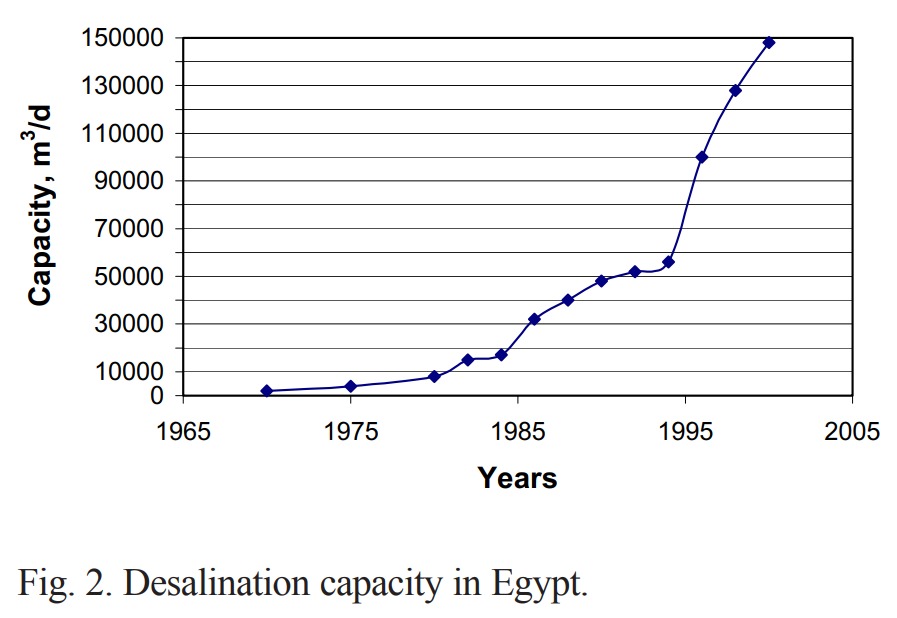Country:
Egypt
Location:
1. Nile Valley and Nile Delta - These are major groundwater systems with significant potential for brackish water exploitation.
2. Western Desert (Nubian Sandstone Aquifer) - Includes deep-seated fossil water resources.
3. Sinai Peninsula - Various aquifers with limited potential but replenished by seasonal rainfall.
Coastal Areas (Mediterranean and Red Sea Coasts) - These areas contain coastal aquifers influenced by seawater intrusion.
4. El Moghra Aquifer - Located west of the Nile Delta, known for its significant volume of brackish water.
5. Eastern Desert and Fissured Carbonate Aquifers - Include locations like Siwa, Qattara, and Farafra with exploitable brackish groundwater resources.
Time period :
1990s up to 2002
Implementing Institution/ Organization:
Groundwater Sector (GWS) under the Ministry of Water Resources and Irrigation (MWRI) in Egypt
Goals
1. Increase Water Availability:
Address the limitations of Egypt's freshwater resources by utilizing the vast quantities of brackish groundwater present in various aquifers.
2. Support Economic Development:
Enhance water supply for key sectors, including agriculture (e.g., salt-tolerant crops), industry, tourism (e.g., Red Sea resorts), and public water supply in remote and coastal areas.
3.
Promote Sustainable Groundwater Management:
Develop a comprehensive policy framework for the sustainable exploitation of groundwater resources, minimizing environmental impacts, and ensuring long-term availability.
4.
Encourage Public-Private Partnerships (PPP):
Stimulate investment and involvement from the private sector through financing models like Build-Operate-Transfer (BOT) and Design-Build-Operate (DBO), particularly in tourism and agriculture.
5.
Leverage Advances in Desalination Technology:
Implement modern desalination technologies such as reverse osmosis (RO) to lower costs and improve the feasibility of using brackish water as an alternative water source.
6.
Environmental Sustainability:
Focus on environmentally sustainable practices, including the disposal and potential reuse of brine, to mitigate negative impacts on local ecosystems.
Objectives
1. Enhance Water Security:
Utilize brackish groundwater as an additional resource to meet the increasing water demand, especially in water-scarce regions and remote areas.
2.
Develop a Comprehensive Groundwater Management Policy:
Formulate policies and frameworks under the Groundwater Sector (GWS) to guide the sustainable exploitation of brackish groundwater, ensuring the protection and efficient use of this resource.
3.Support Agricultural Expansion:
Enable the cultivation of salt-tolerant crops and the establishment of aquaculture (e.g., shrimp farms) through the provision of desalinated brackish water.
4.
Promote Technological Advancements in Desalination:
Implement and expand the use of cost-effective desalination technologies, particularly reverse osmosis (RO), for the treatment of brackish groundwater.
5.
Foster Public-Private Partnerships (PPP):
Encourage investment and involvement from the private sector in desalination projects through various financing and operational models, such as BOT (Build-Operate-Transfer) and DBO (Design-Build-Operate).
6.
Improve Water Supply for Tourism and Industry:
Meet the water needs of the tourism sector (e.g., coastal resorts) and industrial applications, particularly in regions where traditional freshwater resources are not available.
7.
Ensure Environmental Protection and Sustainability:
Address the challenges of brine disposal and mitigate potential environmental impacts through sustainable practices and technologies.
8.
Build Local Capacity and Knowledge:
Enhance technical expertise and capacity within the Ministry of Water Resources and Irrigation (MWRI) and its Groundwater Sector (GWS) through collaborations and knowledge exchange with international partners, such as organizations from the Netherlands.
Methodology (approach)
1. Hydrogeological Assessment
A)
Conduct comprehensive studies and assessments of Egypt’s major aquifer systems (e.g., Nile Valley, Delta, Nubian Sandstone Aquifer, and El Moghra Aquifer) to determine the availability, quality, and potential of brackish groundwater resources.
B)
Map groundwater salinity levels and identify suitable locations for brackish water desalination based on the proximity to demand centers (e.g., coastal areas, agricultural zones).
2. Implementation of Modern Desalination Technologies
A)
Utilize advanced desalination technologies, particularly Reverse Osmosis (RO), for its efficiency in treating both seawater and brackish groundwater.
B)
Explore additional technologies like multi-stage flash evaporation (MSF) for specific industrial applications.
C)
Focus on the scalability of small- to medium-sized desalination plants (500–10,000 m³/day) to meet local needs in various sectors (e.g., tourism, industry, agriculture).
3. Policy Formulation and Institutional Framework
A)
Establish clear policies under the Groundwater Sector (GWS) of the Ministry of Water Resources and Irrigation (MWRI) for managing desalination projects.
B)
Develop guidelines for the sustainable abstraction and use of brackish groundwater, considering the potential impacts on aquifer dynamics and quality.
4. Public-Private Partnerships (PPP) and Financing Models
A)
Promote the involvement of the private sector through financing models such as Build-Operate-Transfer (BOT) and Design-Build-Operate (DBO) to attract investment and expertise.
B)
Collaborate with international partners (e.g., organizations from the Netherlands) for technical support, capacity building, and project implementation.
5. Environmental Considerations
A)
Address the challenge of brine disposal, particularly in coastal areas, by exploring environmentally safe methods for discharging brine into the sea or reusing it in industrial processes.
B)
Implement measures to minimize potential environmental impacts and ensure compliance with local environmental regulations.
6. Pilot Projects and Demonstrations
A)
Initiate pilot projects in key areas (e.g., Red Sea coastal towns, Western Desert oases) to demonstrate the feasibility and effectiveness of brackish groundwater desalination.
B)
Use the results of these pilot projects to refine policies, inform decision-making, and scale up successful models.
7. Capacity Building and Knowledge Transfer
A)
Enhance local expertise through training programs and collaborations with international desalination experts.
B)
Provide technical assistance and share best practices to build the capacity of the Groundwater Sector (GWS) and other relevant institutions.
8. Monitoring and Evaluation
A)
Establish a robust monitoring and evaluation framework to track the performance of desalination projects, assess water quality, and ensure sustainable groundwater management.
B)
Regularly update data on groundwater availability and quality to adapt management strategies accordingly.
Study results
1. Significant Potential of Brackish Groundwater Resources
A)
The study identified large volumes of brackish groundwater in Egypt's major aquifers, including the Nile Valley, Nile Delta, El Moghra Aquifer, Nubian Sandstone Aquifer, and coastal aquifers along the Red Sea and Mediterranean coasts.
B)
The exploitable volume of brackish water across various aquifers was estimated to be substantial, with potential reserves in the Nubian Sandstone Aquifer alone exceeding 100 billion m³.
2. Growing Interest in Brackish Groundwater Desalination
A)
There has been increasing interest in the desalination of brackish groundwater due to advances in desalination technologies (e.g., Reverse Osmosis (RO)) and the reduction in costs.
B)
The study highlighted the growing number of desalination plants in Egypt, particularly small- and medium-sized installations with capacities ranging from 500 to 10,000 m³/day.
3. Successful Pilot Projects and Industrial Applications
A)
Several pilot projects demonstrated the feasibility of using desalinated brackish groundwater in agriculture, tourism, industry, and public water supply, particularly in areas lacking access to conventional freshwater resources.
B)
The tourism sector along the Red Sea coast, for instance, has seen notable success in using desalinated brackish water to meet potable water demands in resorts.
4. Challenges in Brackish Water Exploitation
The study identified several challenges that have limited the exploitation of brackish groundwater, including:
A)
High initial costs and unfamiliarity with desalination technology.
B)
Quality changes in brackish groundwater during exploitation, making it difficult to maintain consistent water quality.
C)
Environmental concerns related to the disposal of brine, particularly in coastal areas where disposal into the sea must be carefully managed to prevent ecological harm.
5. Economic Viability and Cost Analysis
A)
The cost of desalinating brackish groundwater was found to be competitive, especially when compared to alternatives like transporting surface water over long distances or treating heavily polluted surface water.
B)
In the tourism sector, the sale price of desalinated water ranged from LE 8 to LE 12 per cubic meter, significantly higher than the price of conventional drinking water, indicating good financial returns for investors.
6. Promising Public-Private Partnership (PPP) Models
A)
The study highlighted the success of PPP models, such as Build-Operate-Transfer (BOT), in implementing desalination projects. These models attracted private investment, particularly in the tourism and industrial sectors.
B)
There was strong interest from private investors in using brackish groundwater for agricultural development, although environmental concerns limited large-scale implementation.
7. Positive Environmental Impact of Integrated Approaches
A)
Integrating desalination projects with water recycling and reuse strategies showed potential for reducing environmental impact and increasing the sustainability of water use in Egypt.
B)
In some pilot projects, re-infiltration and recycling of treated water were successfully demonstrated, contributing to improved groundwater management and conservation.
8. Need for Enhanced Policy and Regulatory Framework
A)
The study underscored the importance of developing a comprehensive policy framework to guide the sustainable exploitation of brackish groundwater resources, including clear guidelines for brine disposal and groundwater monitoring.
Conclusions
1. Viable Alternative Water Resource
Desalination of brackish groundwater represents a promising and viable solution to address Egypt’s water scarcity challenges, especially in arid and remote regions where conventional freshwater resources are limited.
2. Untapped Potential
Egypt’s aquifers contain vast quantities of brackish groundwater, yet the exploitation of this resource remains limited. There is significant potential for expanding desalination efforts, particularly in the Nile Valley, Delta, and coastal areas.
3. Advancements in Technology and Cost Reduction
Recent advancements in desalination technology, particularly reverse osmosis (RO), have reduced the cost of treating brackish water, making it a more economically feasible option for diverse applications, including agriculture, industry, tourism, and public water supply.
4. Public-Private Partnerships as a Catalyst
The involvement of the private sector through public-private partnership (PPP) models, such as Build-Operate-Transfer (BOT) and Design-Build-Operate (DBO), has proven effective in financing and implementing desalination projects. PPPs are recommended as a key approach to scale up the desalination of brackish groundwater.
5. Environmental and Regulatory Considerations
While the desalination of brackish groundwater offers numerous benefits, there are significant environmental challenges, particularly regarding the disposal of brine. Effective regulatory frameworks and environmentally sustainable disposal methods are necessary to mitigate potential impacts.
6. Need for a Comprehensive Policy Framework
The success of brackish groundwater desalination efforts hinges on the development of a clear and comprehensive policy framework by the Groundwater Sector (GWS) under the Ministry of Water Resources and Irrigation (MWRI). This framework should address sustainable abstraction, environmental protection, and stakeholder engagement.
7. Strategic Role in National Water Management
Desalination of brackish groundwater can play a strategic role in Egypt’s overall water management strategy, providing an essential supplementary source of water that can enhance resilience against water shortages and support economic development, particularly in agriculture and tourism.
8. Recommendations for Future Actions
The study recommends scaling up pilot projects, conducting further hydrogeological studies, and investing in capacity building to enhance technical expertise. These steps will help refine policies, increase the adoption of desalination technologies, and optimize the sustainable use of brackish groundwater resources.
Recommendations
1. Expand Brackish Groundwater Desalination Projects
Increase the implementation of desalination projects targeting brackish groundwater, especially in remote areas and regions with limited access to conventional freshwater resources (e.g., Red Sea coast, Sinai, and the Western Desert).
2. Enhance Public-Private Partnerships (PPP)
Foster greater involvement of the private sector through PPP models such as Build-Operate-Transfer (BOT) and Design-Build-Operate (DBO). This will help attract investment, reduce financial risks, and leverage private sector expertise in desalination technologies.
3. Invest in Advanced Desalination Technologies
Prioritize the adoption of modern, cost-effective technologies like Reverse Osmosis (RO) for desalinating brackish groundwater. Explore new innovations in desalination that can further lower costs and improve efficiency.
4. Develop a Comprehensive Policy Framework
Formulate a clear policy framework under the Groundwater Sector (GWS) of the Ministry of Water Resources and Irrigation (MWRI) to guide sustainable groundwater management. This framework should include guidelines for groundwater abstraction, brine disposal, and long-term monitoring of water quality.
5. Address Environmental Concerns
Implement environmentally sustainable practices for brine disposal, especially in coastal areas. Consider safe methods for discharging brine into the sea and explore options for reusing brine in industrial processes or salt production.
6. Strengthen Hydrogeological Studies and Data Collection
Conduct further hydrogeological assessments to map the availability and quality of brackish groundwater across Egypt’s aquifers. This will provide essential data to support informed decision-making and policy formulation.
7. Promote the Use of Desalinated Brackish Water in Agriculture
Encourage the use of desalinated brackish water for agricultural purposes, particularly for irrigating salt-tolerant crops and supporting aquaculture. Pilot projects should be expanded to demonstrate the feasibility and benefits of using desalinated water in these sectors.
8. Enhance Capacity Building and Knowledge Transfer
Invest in capacity building and training programs for local stakeholders, including engineers, operators, and policymakers. Collaborate with international experts and institutions to share best practices and advance the technical expertise of the Groundwater Sector.
9. Scale Up Pilot Projects
Expand successful pilot projects in key locations (e.g., Red Sea resorts, Western Desert oases) to a larger scale, using the results and lessons learned to refine desalination practices and strategies.
10. Integrate Desalination into National Water Management Plans
Integrate the desalination of brackish groundwater into Egypt’s broader national water management strategy to address water scarcity, support economic growth, and enhance resilience to climate change.
Lessons learned
1. Desalination is a Viable Solution, but Requires Careful Planning
While desalination of brackish groundwater has proven to be a feasible and effective solution for augmenting Egypt’s water supply, it requires thorough hydrogeological assessments and strategic planning to ensure sustainability. The variability in groundwater salinity and quality must be considered in project design.
2. Importance of Technological Innovation
Technological advancements, particularly in Reverse Osmosis (RO), have significantly reduced the costs and increased the efficiency of brackish groundwater desalination. However, adapting technologies to local conditions is crucial for success, as not all methods are equally effective across different aquifers and salinity levels.
3. Public-Private Partnerships (PPP) Drive Project Success
Involving the private sector through PPP models has been instrumental in overcoming financial and technical challenges. Projects that utilized Build-Operate-Transfer (BOT) or Design-Build-Operate (DBO) frameworks demonstrated higher efficiency and better financial outcomes compared to publicly funded projects.
4. Environmental Considerations are Critical
The disposal of brine remains a significant environmental challenge. Improper disposal can lead to soil and water contamination, particularly in coastal areas. Effective brine management strategies, including safe discharge or potential reuse, are necessary to mitigate environmental impacts.
5. Local Capacity Building is Essential
A lack of local expertise and familiarity with desalination technologies was identified as a barrier in the early stages of implementation. Investments in training programs and capacity building have proven crucial in ensuring the successful operation and maintenance of desalination plants.
6. Pilot Projects Provide Valuable Insights
Pilot projects have been effective in testing the feasibility of desalinating brackish groundwater in different regions. These small-scale initiatives provided important data on water quality, costs, and operational challenges, helping to inform larger-scale projects.
7. Economic Viability Depends on Context and Scale
The economic feasibility of desalination projects varies widely based on location, scale, and intended use of the desalinated water. Projects targeting high-value sectors like tourism and industry (e.g., Red Sea resorts) tend to be more financially viable compared to those intended for low-income agricultural use without subsidies.
8. Comprehensive Policy Frameworks are Needed for Sustainable Development
The absence of a cohesive national policy for brackish groundwater desalination initially led to fragmented efforts and limited exploitation of this resource. The development of a comprehensive policy framework has been a key lesson learned for guiding future projects and ensuring long-term sustainability.
9. Stakeholder Engagement Enhances Project Success
Engaging local communities, private investors, and relevant government agencies from the outset has proven to be a critical factor in the success of desalination projects. Transparent communication and involvement of stakeholders help build trust, facilitate smoother implementation, and address potential concerns.
10. Adaptation to Local Conditions is Crucial
The specific geological, hydrological, and environmental conditions of each region significantly influence the choice of desalination technology and operational strategies. Tailoring approaches to local contexts has been essential in achieving optimal outcomes.
References (resources) Found is the case study
- Abelson, P.H. (1991). Desalination of Brackish and Marine Waters. Science, 251, 1289.
-
Abu-Zeid, K.M. (1998). Modern Technology Tools for Water Management. Advanced Short Course on Applications of Modern Technology in Water Resources, Cairo, Egypt.
-
Abu Zeid, M. (1985). Irrigation in Egypt – Present and Future. Paper presented at the 8th Seminar of the Regional Commission on Land and Water Use in Cyprus, FAO, Rome.
-
Allam, M.N. (1987). A Cost Allocation Approach for Irrigation Water in Upper Egypt. Water Res. Manage., 1, 119–129.
-
Attia, B. (1998). Management of Water Resources in Egypt. Short Course, CIHEAM, Cairo, Egypt.
-
Dreyfus, S., & Law, A. (1977). The Art and Theory of Dynamic Programming. Academic Press, New York.
Elgafar, A. et al. (1988). Egyptian Experience in Treating and Usage of Sewage in Agriculture. In: Bescod and Petroworth, Sphinx.
-
Hefny, H., & Attia, F. (1990). Groundwater in the Present and Future. Proceedings of the National Conference on The Future of Land Reclamation in Egypt.
-
Khadr, H.A. (1989). Public Expenditure and Agriculture Taxation Case Study of Egypt. Policy Analysis Division, FAO, Rome.
-
World Bank (1984). Egypt, Environmental Issues. World Bank, Washington, DC.
-
World Resources Institute (1990). World Resources 1990–1991. Oxford University Press, New York.


